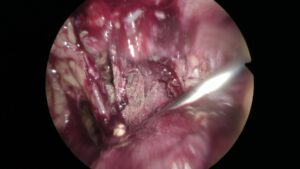Two-Year Delayed Presentation of Retained Surgical Sponge Mimicking Mesenteric
- Home
- Case Studies
- Two-Year Delayed Presentation of Retained Surgical Sponge Mimicking Mesenteric
Dr. Shwetank Prakash is a leading laparoscopic and minimally invasive surgeon in Agra, specializing in advanced surgical treatments for digestive, urological, and colorectal conditions.
Call Us when you Need Help!
Gossypiboma
Not To Be Disclosed
Female
35 Year Old
Gossypiboma

About Case
Gossypiboma is a rare but serious postoperative complication involving retained surgical sponges, often diagnosed late due to nonspecific symptoms. We report a case of a 35-year-old woman who presented with chronic colicky abdominal pain two years after her last lower segment caesarean section (LSCS). MRI suggested a mesenteric abscess or infected mesenteric cyst. Diagnostic laparoscopy revealed a retained surgical sponge encased in a granulomatous mass. This case highlights the diagnostic challenge and medicolegal significance of gossypiboma.
Symptoms Encountered
A 35-year-old female presented to the outpatient department with complaints of intermittent colicky abdominal pain for the past 4–5 months. The pain was localized to the umbilical region, with no associated fever, vomiting, or bowel disturbances. There was no history of hypertension or diabetes. Her obstetric history included two LSCS deliveries, the most recent being two years ago.
On physical examination, a 3 × 3 cm firm lump was palpated in the supraumbilical region, non-tender with limited mobility. No signs of acute inflammation were noted.
Radiological Evaluation:
MRI abdomen revealed a 66.3 × 46.6 × 55.3 mm well-defined lobulated lesion in the umbilical region, showing T1 hypointensity and T2 hyperintensity, with internal debris and septations, suggestive of a mesenteric abscess. Mild surrounding fat stranding was noted. The radiologist (Dr. Vignesh Balasubramanian) included infected mesenteric cyst in the differential diagnosis. No abnormalities were seen in the hepatobiliary or pancreatic systems.

Surgical Intervention:
Procedure Details
- Following preoperative work-up, the patient underwent diagnostic laparoscopy.
- Intraoperatively, dense adhesions were noted in the anterior abdominal wall.
- After careful adhesiolysis, a well-encapsulated abscess cavity was exposed. Surprisingly, a 10 cm retained surgical sponge was found within the cavity, surrounded by a foreign body granuloma.
- The sponge was removed in toto, and purulent material was drained and sent for culture and sensitivity testing.
- The abdominal cavity was thoroughly irrigated with saline.
Postoperative Course:
- The patient recovered uneventfully. Antibiotics were administered based on culture sensitivity results. At follow-up, she remained symptom-free with no recurrence on ultrasound.
- This case underscores the critical importance of surgical safety protocols, including sponge counts and postoperative vigilance. Retained foreign bodies are preventable and have significant medico legal implications. A high index of suspicion should be maintained in any patient presenting with unexplained abdominal symptoms and a history of prior surgery.
